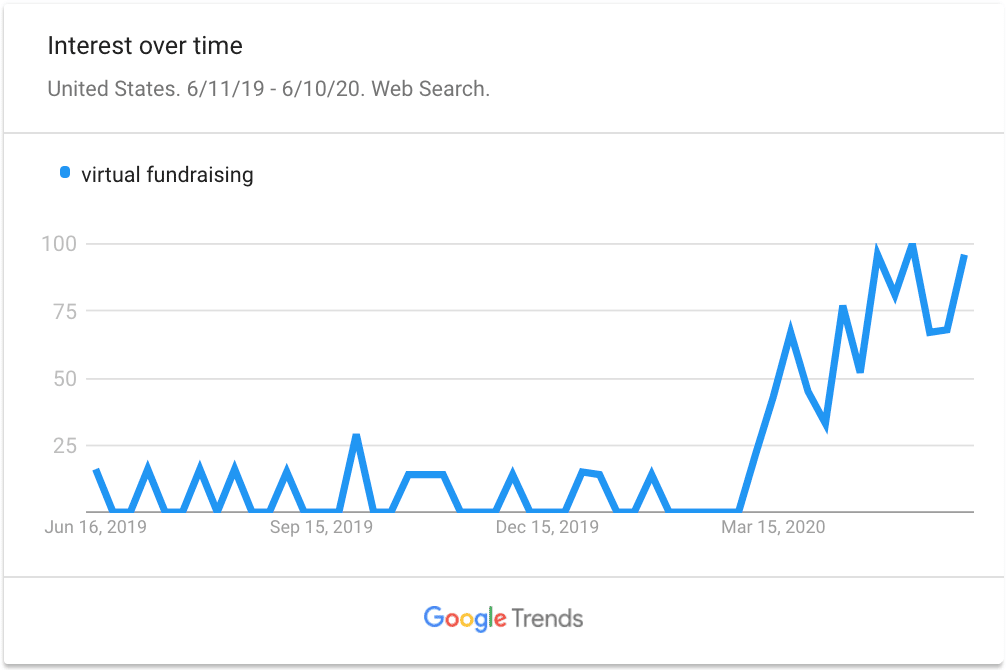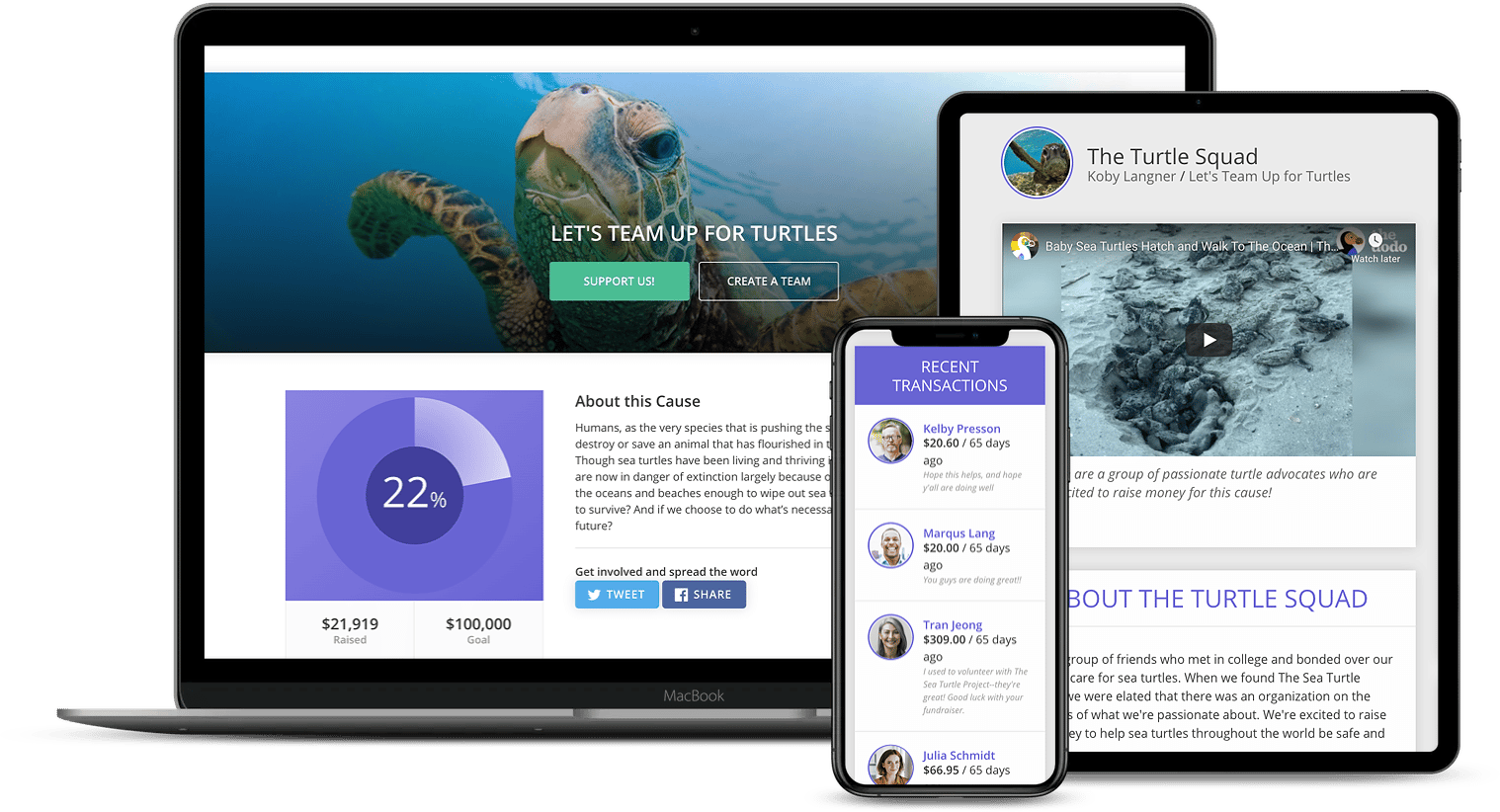Upgrade Your Virtual Fundraising Strategy With A Peer-To-Peer Campaign

As nonprofits continue to face coronavirus restrictions for in-person events and meetings, organizations are adapting by shifting to virtual fundraising and finding creative ways to meet with donors. Online searches for virtual fundraising began to spike as early as March as fundraisers looked for alternative strategies.

Image: Google Trends line graph showing a spike in interest for virtual fundraising starting March 8, 2020.
In this post, we’ll share how you can use virtual fundraising techniques to execute a peer-to-peer fundraising event. If you’re familiar with peer-to-peer fundraising, you know that it’s an incredible way to raise funds for your organization. We’ll share tips for success and recommendations for each step of the way.
Here are the steps we’ll cover:
- Decide On Your Peer-To-Peer Fundraising Platform
- Plan Your Virtual Peer-To-Peer Campaign & Design Your Online Fundraising Page
- Motivate Your Supporters To Participate In The Virtual Campaign
- Thank Your Fundraisers For Participating In The Campaign
1. Decide On Your Peer-To-Peer Fundraising Platform
Before you can create your virtual peer-to-peer fundraiser, you need to have the right tools in place. In this case, that means choosing a fundraising platform that will help you collect donations from your supporters. There are many options out there, including these 9 peer-to-peer platforms we think would be a good fit for nonprofits.
Our recommendation: Think about your goals and keep those in mind as you look through the different options. Don’t forget to take into account the different fees associated with each platform so you can stay within your organization’s budget. If there are certain tools you want to continue to use, make sure the platform integrates with them.

Image: Example of a peer-to-peer fundraising platform you can use for virtual fundraising.
2. Plan Your Virtual Peer-To-Peer Campaign & Design Your Online Fundraising Page
Now that you’ve got your tools in place, it’s time to plan your virtual peer-to-peer fundraiser. There are many different components that make up a successful online campaign, including:
Messaging: What is the “why” of your campaign? What is the reason you’re asking supporters to fundraise on your organization’s behalf? Is there a specific program you want to fund? A specific initiative you want to support?
There may be times when you want to raise money for your operating budget (like during an end-of-year giving campaign), but even in that case, you’re going to want to tell a story for your audience so they understand exactly what’s at stake and why they should participate. Ideally your “why” will also be fun or moving and be unique to your organization.
Goal: Once you know why you’re raising money, you need to decide how much money you want to raise. You’re asking people to commit their time and energy so make sure the ask is proportionate. If you’re hoping to raise a smaller amount of money, consider that it may be easier to have your fundraising team reach out to a certain number of donors to hit that goal instead of mobilizing a group outside of your organization. If you’re wondering more about how to set a goal, check out Classy’s* blog post on setting SMART goals.
Timeline: Is your campaign evergreen or time-restricted? Is it limited to one day like Giving Tuesday? Now that you have your goal, set a timeline during which you want to achieve it. The more urgent you make the goal, the better. People will feel more compelled to give.
Branding: Make sure your online fundraising platform gives your organization and supporters the ability to customize their online fundraising pages to match your organization’s brand. It’s important to be able to tell your story visually and to have the space to add personal descriptions. The more legitimate your campaign looks, the more likely you are to receive donations.
Incentives: Although this isn’t possible for all organizations, we recommend having some incentives you can give to fundraisers and supporters once they hit a fundraising goal. This will be a great motivating tactic over the course of the campaign, which is especially important if your campaign runs for several weeks or longer.
Communication plan: How are you going to promote your campaign on your website, via your social media accounts, and through your newsletter? Are you going to have a launch team that helps you kick the campaign off? What resources will you provide to fundraisers to help them succeed? How are you going to communicate with and thank donors during the span of the campaign?
The ability to tell your nonprofit’s story and share that “why” we mentioned above is going to hinge on how prepared you are in this respect so make sure you go into your campaign with a strong plan. If you’re looking for more resources, check out how to write an effective peer-to-peer fundraising email and our five peer-to-peer communication tips to help motivate your fundraisers.
Our recommendation: Start planning your virtual peer-to-peer campaign well before you launch it and make sure you ask yourself how you can set your organization and supporters up for success. Once you have your plans in place, you can launch and promote your campaign.
3. Motivate Your Supporters To Participate In The Virtual Campaign
You’re responsible for making sure that your supporters stay motivated to participate in the campaign. There are many ways to do this, including:
Communicate often: Don’t just wait until the end of the campaign to touch base with your fundraisers. Talk to them throughout the campaign: remind them why they’re important and how they’re impacting your mission.
Celebrate your wins: In addition to setting an overall campaign goal, we recommendation calling out specific milestones along the way. When you hit a milestone, check in with the fundraisers who got you there and celebrate those wins. This builds momentum and encourages people to continue working hard on behalf of your worthy cause.
Promote your incentives: If you’re in a position to offer incentives, make sure you remind fundraisers what they are and what they stand to gain from participating in your campaign.
Remind them of the impact: Don’t let the people involved in your campaign forget what your “why” is and why it’s important. This messaging should drive everything you put out to the public and should be the main motivating force that drives the success of your campaign.
Our recommendation: In addition to these motivators, you need to keep in mind that the easier you make this on your supporters, the better. Think about what resources you can provide to them – tips, templates, visuals, and more – that will equip them with the tools they need to successfully promote the fundraiser and provide the fundraisers with them as early as possible. This should be an important part of your communication plan.
4. Thank Your Fundraisers For Participating In The Campaign
Once your campaign ends, you need to thank your donors and supporters as soon as possible (even if you didn’t hit your goal). Use this time to remind them of the impact they made and share how they can stay up to date on the initiatives they helped fund.
Our recommendation: Include a strategy for thanking your donors and supporters in your communication plan so you’re prepared to do this as soon as the campaign ends. Consider writing personalized thank you notes to your donors and fundraisers.
Don’t miss our webinar panel on launching a successful virtual peer-to-peer fundraising campaign. Looking for additional information? Check out our peer-to-peer fundraising and crowdfunding resources for nonprofits.
*indicates a Kindful integration partner
Schedule a live demo with our partner Bloomerang, and we’ll show you how easy it is to create and automate reports, utilize online and offline fundraising tools, quickly integrate and access all your data, and ultimately create more time to engage your donors.